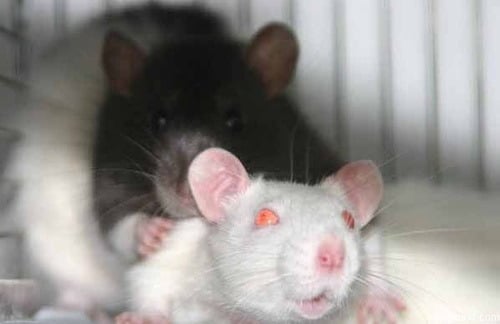Youth and intense sexual arousal are a surprisingly volatile combination
Research on animals suggests that first sexual experiences may have more power to shape our individual sexual proclivities than we would guess, and that they do so via specific brain mechanisms. Consider the following research on young, virgin rats:
“What is that scent you’re wearing, dear?”
Researcher Jim Pfaus sprayed sexually receptive female rats with cadaverine (odor of decaying flesh) and placed them in cages with young virgin males. Normally rats avoid decaying flesh. It’s innate; it’s not a learned behavior. They will bury dead buddies and wooden dowels soaked in cadaverine.
However, this was a chance for these young males to lose their V cards. With their dopamine soaring in anticipation, they mated and ejaculated several times. (Dopamine is the “gotta get it” neurochemical behind appetites, motivation, conditioning and addiction.)
A few days afterward, the young rats were placed in a large cage with normal-smelling females and females smelling like death. The cadaverine-conditioned rats got it on indiscriminately. Normal, experienced control males wouldn’t go near the females that stank of death.
How deep was the conditioning? A few days later, the conditioned ex-virgins received a wooden dowel saturated in cadaverine. They played with it, and many gnawed on it—just as they would if the dowel had been laced with something they normally love, such as chocolate or vaginal secretions. Could this explain why today’s young porn users often complain that they end up hooked on porn that doesn’t match their fundamental sexual orientation or self-image?
“Why is this dude so hot?”
A virgin male rat can be conditioned to prefer a same-sex partner in about two weeks by jacking up his dopamine artificially (thus imitating the buzz of sexual arousal). Researchers injected a virgin male rat with a dopamine agonist (a drug that mimics dopamine), and then placed him in a cage with another male. The two rats just hung out together for a day. (The dopamine agonist is out of the system in about one day.) Researchers repeated this 2 more times, 4 days apart.
A few days later, the reconditioned male was put to the test. With no dopamine agonist in his system, he was placed into a cage with both his male buddy and a sexually receptive female (remember the dopamine was out of his system). Guess which rat turned him on the most? He showed much more response to the male. Interestingly, if the buddy was also a virgin the conditioned rat and he just demonstrated a social affinity. However, and somewhat mysteriously, if the buddy was a sexually experienced rat, the conditioned virgin showed more erections, more genital investigation, and even female-like solicitations —as opposed to normal male mounting behavior. The researchers noted that the virgin rat wasn’t gay, as he didn’t try to mount the other rat. Yet his sexual behavior had definitely veered from the trajectory it would have followed without the same-sex conditioning. (Is this evidence of how easily adults might influence youngsters’ innate sexual behavior?)
An earlier experiment revealed that female rats couldn’t be conditioned this way – only males. Also, the same-sex perference was gone 45 days after scientists stopped the artificial conditioning, which may help explain why some young men quit porn and notice that their extreme sexual tastes return to earlier tastes.
The neurochemistry of sexual conditioning
You may remember with surprising clarity the first sexually enticing image/person you saw, or the first erotic touch you received. Why are early sexual cues/experiences so powerful? The reason is neurochemical. Adolescent brains are at their peak of (1) dopamine levels, (2) sensitivity to dopamine signaling and (3) vulnerability to addiction. Their ΔFosB levels are also higher than in adults. (More on ΔFosB in a moment.)
Novel, startling, arousing stimuli can rock an adolescent’s world in a way they won’t an adult’s. This neurochemical reality primes young brains to choose sexual targets according to what offers the biggest sexual buzz. Obviously, this works well in an environment where the only intense sexual stimuli ultimately lead an adolescent toward encounters with real mates.
Yet this neurochemical reality is why scientists warn that adolescents are more at risk than adults for addiction. Research shows that their hypersensitivity to arousal means teens find novelty, shocking things, and even repulsive things more exciting than adults do. This makes them extremely vulnerable to having their sexuality wired up to any intense, edgy experience, in comparison with adults. Think gonzo porn.
When dopamine naturally soars in connection with early sexual experiences, the mammalian brain responds by producing a molecule known as ΔFosB. A 2013 study confirmed that it consolidates sexual conditioning. ΔFosB helps the brain alter itself physically so that future sexual experiences (and all related cues) register as high priorities. Dendrites sprout to make related cues more arousing, wariness is relaxed when such cues show up, etc. Addictions also hijack this ΔFosB mechanism, triggered by chronic overconsumption of dopamine-elevating activities and substances.
Scientists believe that, evolutionarily speaking, a top priority for ΔFosB is to wire up first sexual experiences (and any particularly intense sexual experience thereafter), in hopes of improving reproductive success. In the case of the rat’s first cadaverine-laced sexual experience the message of ΔFosB was, “Remember: The smell of death is hot—because it’s present during your first sexual experience!”
“Why can’t I slow down?”
Early sexual conditioning can stick around. In contrast, sexual conditioning is far more elastic if it occurs after normal mating patterns are established. Consider this research recounted in Pfaus’s review of sexual conditioning. Scientists introduced a receptive female to a male and then, a minute later, yanked her out of his cage. With enough repetitions, this conditioned him to ejaculate much faster than normal. If the males learned this pattern during their first sexual experiences, it stuck with them—even when they were later allowed uninterrupted access to females.
To see the difference, the researchers also taught experienced males (which had learned sex at normal speeds) to ejaculate faster, by yanking the females after a minute. However—unlike the rats whose sexual behavior was conditioned from the start—the experienced rats fell back to normal mating behavior when allowed uninterrupted access to females.
This research lines up with experiments involving human adults. In response to small monetary incentives, adults were able to control their sexual response a bit while in the lab, but the effect had disappeared in later trials.
 The suggestion that early sexual conditioning is more potent than later sexual conditioning also aligns with what we hear from porn-users recovering from ED. Guys who developed their sexuality before they used Internet porn only need a couple of months to recover from porn-induced ED and enjoy 3-D sex. Chances are they wired their early sexual arousal to imaginings inspired by real potential mates and (somewhat) realistic sexual scenarios, or perhaps they used static porn requiring imagination. Real sex seemed more intense by comparison.
The suggestion that early sexual conditioning is more potent than later sexual conditioning also aligns with what we hear from porn-users recovering from ED. Guys who developed their sexuality before they used Internet porn only need a couple of months to recover from porn-induced ED and enjoy 3-D sex. Chances are they wired their early sexual arousal to imaginings inspired by real potential mates and (somewhat) realistic sexual scenarios, or perhaps they used static porn requiring imagination. Real sex seemed more intense by comparison.
In contrast, guys with sexual performance problems, who started out masturbating to Internet porn, often need up to six months or even longer to achieve satisfactory sex with a real partner. Most wired their early sexuality to streaming, hi-def vids, extreme material, endless novelty and no imagination needed due to the ready availability of Internet erotica. When they finally connect with a real mate, some report that they “feel nothing” during oral or vaginal sex.
Their brains wired early on to porn’s voyeur-perspective, emphasis on favorite body parts and fetishes, and constant novelty, which registers as more intense than real partners (because it sustains elevated dopamine).
They have trained for the wrong sport. Some of them have to stop climaxing to pixels for a lengthy period before their brains will look around for other (3-D) sexual stimuli. (Read one guy’s amusing, poignant account of how challenging this process can be: You Built A Harem. Keep in mind that he was older and had actually learned to fall in love before he met Internet porn.)
Youthful sexual conditioning matters
Rats offer the best opportunity for understanding the power of first sexual experiences in scientific terms. After all, it would be unethical to risk manipulating a virgin human’s sexuality in the lab in such profound ways.
There’s little reason to doubt that youthful humans are similar to rats when it comes to wiring up early sexual experiences. Indeed there is already extensive human research demonstrating that adolescent/pubescent brains are vastly more sensitive to reward than adult brains. Additional research shows that by adulthood teens prune back unused neurocircuitry, so if teens have wired to something bizarre, sex with real mates may be more challenging to master. See Why Shouldn’t Johnny Watch Porn If He Likes?
The next time you hear someone argue that “Kids are sexual and no one should restrict their sexual choices,” remind them that kids’ brains are particularly vulnerable to wiring sexuality to highly stimulating sexual cues, real or synthetic. Moreover, the research described earlier suggests that intense sexual stimulation has the power to alter the original trajectory of an individual’s sexuality in unexpected ways. Once someone begins climaxing to a particular stimulus each orgasm reinforces the association, making it harder to revert to one’s original trajectory.
The longer kids can spend wiring to age-appropriate sexual cues provided primarily by their peers, the better. If they wish to explore the kinky side of life let them do so after they reach adulthood and their brains are no longer hyper-plastic and hyper-reactive to sexual cues.
UPDATES:
Results also indicate that mating increased co-expression of Fos in NOS-containing neurons, and that this increase was highest in animals undergoing their first sexual encounter, indicating that initial sexual experience increases NO production in the mPOA of male rats. [Note: NOS=nitric oxide synthase]
Adolescent Brain Meets Highspeed Internet Porn (2013) – half-hour presentation on sexual conditioning and the adolescent brain.
Growing scientific evidence of a lingering post-orgasm cycle (studies)
Studies on the overlap between sex and drugs in the brain
Studies Find Escalation (and Habituation) in Porn Users (2016)
Evaluation and hedonic value in mate choice (2018)

